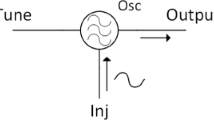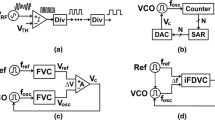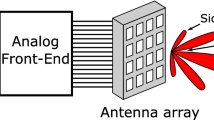Abstract
In this paper, the injection-locked oscillator (ILO)-based receiver is investigated. The key design considerations of the ILO including the phase difference between the input and output signals and its impact on the ILO-based receiver are analysed in detail. Different strategies for both the narrow and wide-band applications are discussed and simulated. As a design example, a 2.4 GHz ILO-based receiver is implemented using a standard 40 nm CMOS technology, where a three-stage inverter-based ILO is optimised to maintain a good balance among working range, sensitivity and power consumption, etc. Measurement results show that the proposed receiver is able to demodulate an input signal at a 2.4 GHz carrier frequency with the data rate up to 1 Mbps while consuming \({<}300\, \upmu \hbox {W}\) power. It is suitable for short-range communication system such as chip-scale data link.
















Similar content being viewed by others
References
M. Baghaei-Nejad, D.S. Mendoza, Z. Zou, S. Radiom, G. Gielen, L.R. Zheng, H. Tenhunen, A remote-powered RFID tag with 10Mb/s UWB uplink and \(-\)18.5 dBm sensitivity UHF downlink in \(0.18\upmu \text{m}\) CMOS, in Solid-State Circuits Conference—Digest of Technical Papers, 2009. ISSCC 2009. IEEE International (2009), pp. 198–199,199a. doi:10.1109/ISSCC.2009.4977376
P. Bhansali, J. Roychowdhury, Gen-Adler: the generalized Adler’s equation for injection locking analysis in oscillators, in Asia and South Pacific Design Automation Conference (2009), pp. 522–527. doi:10.1109/ASPDAC.2009.4796533
W. Da Toh, Y. Zheng, C.H. Heng, Low power digital baseband for impulse radio ultra-wideband transceiver. Circuits Syst. Signal Process. 31(1), 223–235 (2012). doi:10.1007/s00034-010-9249-6
D.C. Daly, A.P. Chandrakasan, An energy-efficient OOK transceiver for wireless sensor networks. IEEE J. Solid-State Circuits 42(5), 1003–1011 (2007). doi:10.1109/JSSC.2007.894323
S. Drago, D.M. Leenaerts, F. Sebastiano, L.J. Breems, K.A. Makinwa, B. Nauta, A 2.4GHz 830 pJ/bit duty-cycled wake-up receiver with -82dBm sensitivity for crystal-less wireless sensor nodes, in IEEE International Solid-State Circuits Conference, 2010. ISSCC 2010 (2010), pp. 224–225. doi:10.1109/ISSCC.2010.5433955
X. Huang, S. Rampu, X. Wang, G. Dolmans, H. de Groot, A 2.4 GHz/915 MHz 51 \(\upmu \)W wake-up receiver with offset and noise suppression, in IEEE International Solid-State Circuits Conference, 2010. ISSCC 2010 (2010), pp. 222–223. doi:10.1109/ISSCC.2010.5433958
K. Iniewski, Wireless Technologies: Circuits, Systems, and Devices (CRC Press, Boca Raton, 2007)
H.B. Kia, A.K. A’ain, I. Grout, I. Kamisian, A reconfigurable low-noise amplifier using a tunable active inductor for multistandard receivers. Circuits Syst. Signal Process. 32(3), 979–992 (2013). doi:10.1007/s00034-012-9505-z
H. Li, S. Chen, L. Yang, R. Bai, W. Hu, F.Y. Zhong, S. Palermo, P.Y. Chiang, A 0.8 V, 560 fJ/bit, 14 Gb/s injection-locked receiver with input duty-cycle distortion tolerable edge-rotating 5/4X sub-rate CDR in 65 nm CMOS, in Symposium on VLSI Circuits Digest of Technical Papers (2014), pp. 1–2. doi:10.1109/VLSIC.2014.6858399
X. Li, P. Baltus, P. Van Zeijl, D. Milosevic, A. Van Roermund, A 70 GHz 10.2 mW self-demodulator for OOK modulation in 65-nm CMOS technology, in IEEE Custom Integrated Circuits Conference, 2010. CICC 2010 (2010), pp. 1–4. doi:10.1109/CICC.2010.5617447
B. Mesgarzadeh, A. Alvandpour, First-harmonic injection-locked ring oscillators, in IEEE Custom Integrated Circuits Conference, 2006. CICC 2006 (2006), pp. 733–736. doi:10.1109/CICC.2006.320927
N.M. Pletcher, S. Gambini, J. Rabaey, A 52 \(\upmu \)W wake-up receiver with \(-\)72 dBm sensitivity using an uncertain-IF architecture. IEEE J. Solid-State Circuits 44(1), 269–280 (2009). doi:10.1109/JSSC.2008.2007438
J.M. Rabaey, A.P. Chandrakasan, B. Nikolic, Digital Integrated Circuits: A Design Perspective (Prentice Hall, Upper Saddle River, 2003)
S.P. Sah, P. Agarwal, D. Heo, A low power 8th sub-harmonic injection locked receiver for mm-Wave beamforming applications, in IEEE Radio Frequency Integrated Circuits (RFIC) Symposium (2014), pp. 401–404. doi:10.1109/RFIC.2014.6851752
B. Shi, M.Y.W. Chia, Design of a noise-canceling CMOS wideband receiver front-end with inherent active balun. Circuits Syst. Signal Process. 30, 741–753 (2011). doi:10.1007/s00034-011-9303-z
X. Wang, A. Dinh, D. Teng, A 3–10 GHz ultra wideband receiver LNA in 0.13 \(\upmu {{\rm m}}\) CMOS. Circuits Syst. Signal Process. 33(6), 1669–1687 (2014). doi:10.1007/s00034-013-9726-9
X.P. Yu, Z.H. Lu, B.Y. Hu, W.M. Lim, E.T. Duo, K.S. Yeo, A 12-mW 40–60-GHz 0.18-\(\upmu {{\rm m}}\) BiCMOS oscillator-less self-demodulator for short-range software-defined transceivers. IEEE J. Emerg. Sel. Top. Circuits Syst. 3(4), 521–530 (2013). doi:10.1109/JETCAS.2013.2284619
Acknowledgments
This work is supported by National Science Foundation China (Grant number 61274034 and 61574125) and the ZJU-SUTD Joint research project under the Fundamental Research Funds for the Central Universities (no. 2015XZZX001-01).
Author information
Authors and Affiliations
Corresponding author
Rights and permissions
About this article
Cite this article
Yu, X.P., Liu, Z., Fan, D.Z. et al. The Investigation and Optimisation of Phase-Induced Amplitude Attenuation in the Injection-Locked Ring Oscillators-Based Receiver. Circuits Syst Signal Process 36, 1818–1835 (2017). https://doi.org/10.1007/s00034-016-0405-5
Received:
Revised:
Accepted:
Published:
Issue Date:
DOI: https://doi.org/10.1007/s00034-016-0405-5




